Japanese Dinner Recipes Your Family Will Love
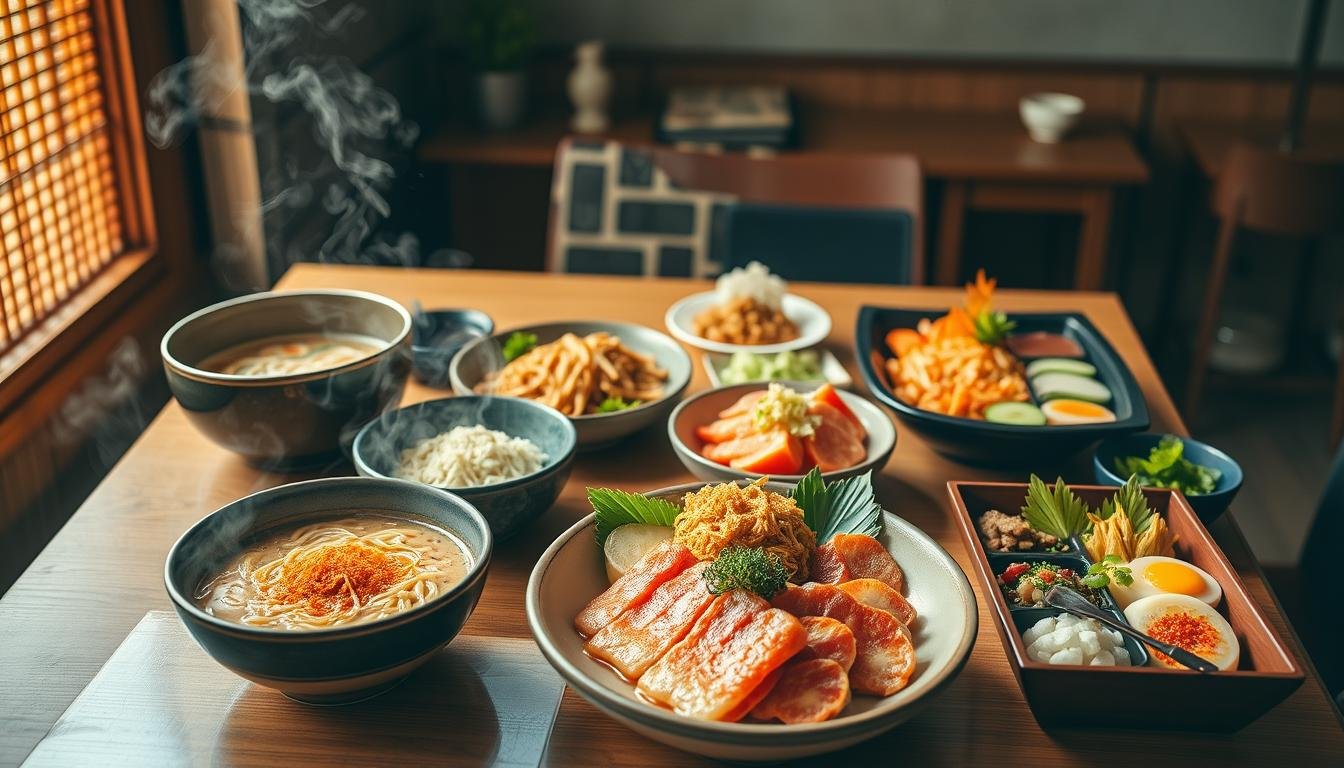
Have you ever made a meal that brought everyone together? I’ll never forget the first time I made Shabu Shabu. Seeing my family’s happy faces as we cooked beef in broth was special. That’s the magic of Japanese meals; they turn simple food into special memories.
Start making Japanese food at home tonight! Whether it’s for a quiet family meal or a big gathering, these recipes are easy and tasty. You’ll love the Shabu Shabu and the quick Unagi Don. Each recipe is a chance to enjoy great flavors without spending all day cooking.
Key Takeaways
- Discover the joy of cooking Japanese dinner recipes that bring the family together.
- Shabu Shabu is a communal hot pot dish, perfect for family dinners.
- Unagi Don offers a quick and delightful homemade Japanese dinner idea.
- Japanese cuisine can fit easily into your weeknight dinner routine.
- Enjoy authentic flavors without spending hours in the kitchen.
Introduction to Japanese Cuisine
Welcome to your journey into the world of Japanese cuisine! It’s not just about food. It’s about embracing a culture that values freshness, simplicity, and elegance. Looking for traditional Japanese dinners or just starting with Japanese food? You’ll find what you need to explore these culinary treasures here.
What Makes Japanese Food Unique?
Japanese cuisine is known for its unique blend of taste, texture, and presentation. It focuses on enhancing the natural flavors with minimal seasoning. This approach showcases the quality of ingredients like fresh fish, vegetables, and rice. Traditional Japanese dinners also feature seasonal ingredients and time-honored techniques. These make the dishes delicious and visually stunning.
Essential Ingredients in Japanese Cooking
When diving into Japanese cooking, some ingredients are key. Soy sauce, miso, and kombu are essential. They provide the deep umami flavor. Kombu, a seaweed, is used in dashi, a key broth. Miso adds richness to soups and marinades. Soy sauce is versatile, enhancing everything from sushi to vegetables. These ingredients are crucial for traditional Japanese meals.
Classic Japanese Dishes
Welcome to the exciting world of classic Japanese foods! We’ll explore sushi, ramen, and tempura. You can make these dishes at home. They bring Japan’s unique flavors into your kitchen. Your family and friends will love it.
Sushi: A Guide to Making It at Home
Making sushi at home can be fun. You need sushi rice, seaweed, fresh fish, and veggies. The secret is in preparing the rice. Wash it until water runs clear and cook it with rice vinegar. Then, add your favorite fillings. Soon, you’ll be making sushi like a pro!
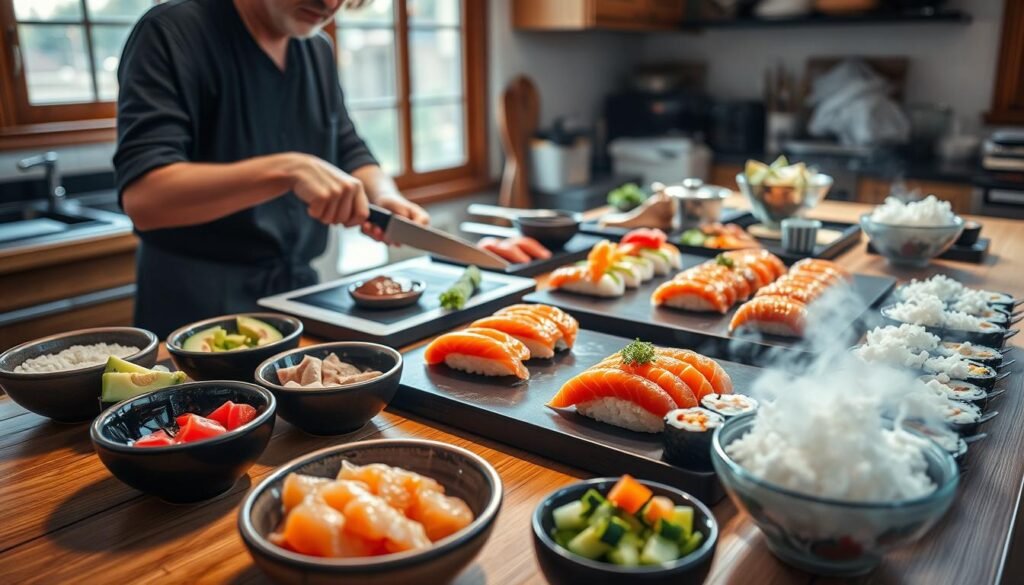
Ramen: Crafting the Perfect Bowl
We’re now looking at a favorite comfort food: ramen. With our homemade ramen guide, you’ll make an amazing bowl. Start with a tasty broth made from pork, chicken, or veggies. Cook noodles until they’re just right.
Next, add sliced pork, a soft boiled egg, scallions, and nori. Getting the balance right is the trick to a great ramen bowl. It’ll feel like you’re in Japan.
Tempura: Lightly Fried Delights
Want to try making tempura? It’s easier than you think. The key is the cold batter; mix it but not too much. Coat ingredients like shrimp or sweet potatoes lightly, then fry. They come out golden, crispy, and light. Tempura is a fun way to enjoy veggies and seafood!
Easy Weeknight Japanese Recipes
Are you looking for a delicious meal but short on time? Quick Japanese dinners are the solution! These recipes are great for any cook. You can enjoy a tasty teriyaki chicken. Or dive into stir-fried udon that’s both easy and exciting. Time to start cooking!
Teriyaki Chicken: Quick and Flavorful
Think about chicken in a sweet teriyaki sauce. Sounds good, doesn’t it? This teriyaki chicken recipe can be ready in under 30 minutes. You just need soy sauce, mirin, and sugar. Serve it with rice and sesame seeds for an easy, yummy meal.

Stir-Fried Udon: A One-Pan Wonder
Want noodles? Try this stir-fried udon recipe. Udon noodles are thick and perfect for stir-frying. Add veggies and your favorite protein for a fast meal. This dish is simple and flexible. Plus, cleaning up is easy, making it perfect for busy nights.
Vegetarian Japanese Recipes
Vegetarian Japanese recipes make dinner exciting! Think of colorful veggie sushi rolls and simple miso soup. These dishes are tasty and healthy. They’re great for any meal.

Vegetable Sushi Rolls: Fresh and Delicious
Vegetable sushi rolls are a perfect vegetarian treat. They have crisp cucumbers, creamy avocado, and carrots. Fresh veggies and good sushi rice are key. You’ll love the flavors you can make!
Miso Soup: A Comforting Classic
Miso soup is top-notch comfort food. Making how to make miso soup is easy. You need miso paste, tofu, seaweed, and green onions. It’s warm, nutritious, and tasty. Try it for a real Japanese meal!
Family-Friendly Japanese Dishes
Japanese food is not only for adults. It has lots of dishes families will love. Think crispy chicken katsu and tasty donburi bowls. Are you ready to try these amazing Japanese chicken dinners?
Chicken Katsu: Crispy and Tender
The chicken katsu recipe is perfect if you want something crispy yet tender. Kids and grown-ups love the panko-breaded chicken cutlet fried until it’s golden. Add some tonkatsu sauce and shredded cabbage. Your family will definitely want more!

Donburi: Rice Bowls for Everyone
Donburi rice bowls are great for family meals too. They start with steamy rice topped with choices like teriyaki chicken or beef. What’s cool about donburi is you can change the toppings as you like. It’s easy to see why so many families enjoy them!
User-Friendly Meal Prep Tips
Planning your Japanese meal prep dinner ahead can save you time and stress. Embrace these tips to make cooking easier. Enjoy delicious Japanese meals without any hassle!
Preparing Ingredients in Advance
Start your ingredients early to simplify Japanese food prep. I chop vegetables and marinate proteins ahead. This way, dinner time is stress-free. Prepping helps me focus on cooking without stopping. Having everything ready makes a big difference!
Storing and Reheating Japanese Dishes
Now, let’s talk about keeping Japanese dishes tasty. Proper storage keeps meals fresh and delicious. I use airtight containers for this. When reheating, avoid the microwave when possible. Stovetop or oven reheating keeps the authentic flavors.
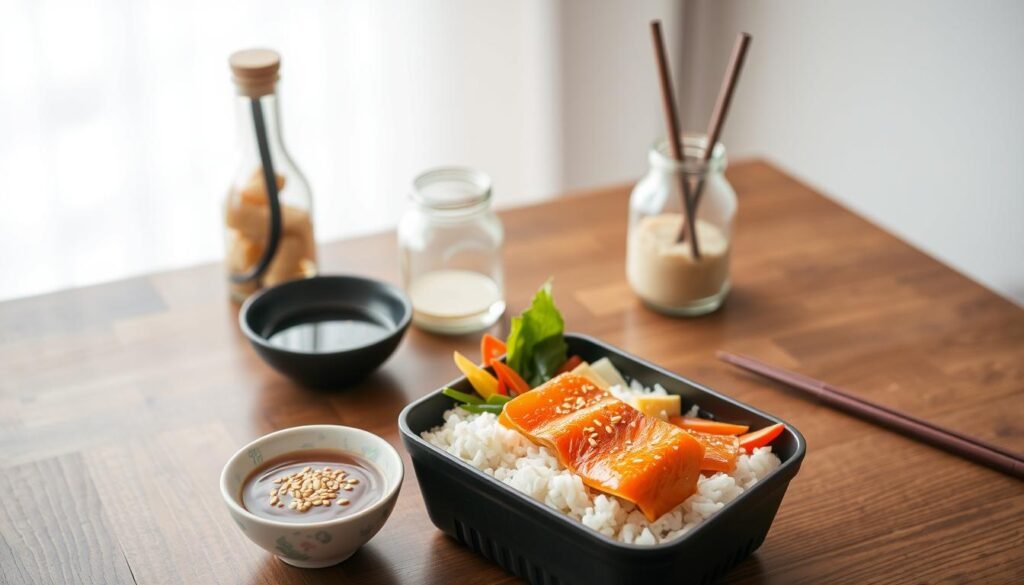
These simple tips help store and reheat Japanese meals, keeping them tasty. Planning ahead makes your Japanese meal prep smooth and enjoyable!
Traditional Japanese Sides
No Japanese meal is complete without perfect sides. These traditional sides make the meal even better. They add amazing flavors and textures. From the tangy crunch of pickles to the savory gyoza, fans of Japanese food must try these. Let’s explore more!
Pickled Vegetables: A Must-Have
Pickled vegetables, or “tsukemono,” are key to a traditional meal. They bring a tangy burst of color and taste. Plus, they cleanse your palate between different dishes. Pickling cucumbers, daikon, and carrots is easy and makes meals authentic. With just salt and vinegar, you can make a side that goes well with sushi and rice.

Gyoza: Japanese Dumplings to Love
Everyone enjoys gyoza, the delightful Japanese dumplings. They’re filled with tasty ingredients and are a joy to eat. Whether as an appetizer or a main, they balance meat, cabbage, garlic, and ginger inside a thin wrapper. Pan-frying then steaming them creates a perfect gyoza. They are great by themselves or alongside other dishes.
| Side Dish | Ingredients | Preparation Time | Notes |
|---|---|---|---|
| Pickled Vegetables | Cucumbers, Daikon, Carrots, Salt, Vinegar | 20 mins (plus pickling time) | Ensure vegetables are thinly sliced for best results. |
| Gyoza | Ground Meat, Cabbage, Garlic, Ginger, Gyoza Wrappers | 45 mins | Pan-fry then steam for the perfect texture. |
Incorporating Japanese Flavors
Japanese flavors make meals more exciting! Ever thought about adding a unique umami taste to your food? Let’s explore how to use Japanese ingredients in your kitchen.
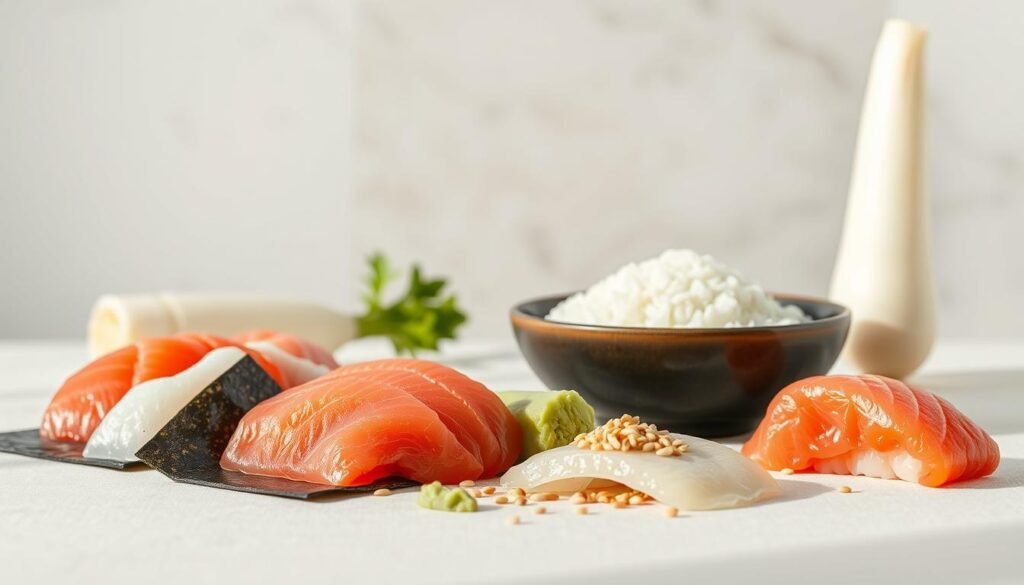
Using Miso in Everyday Cooking
Miso changes the game in cooking. It adds savory and sweet flavors. Try miso in soups, marinades, and dressings.
Think about miso-glazed salmon or a comforting miso soup. Each dish becomes more thrilling.
Soy Sauce: Beyond the Basics
Soy sauce does more than sushi dips! Its deep flavor enhances many dishes. Use it in braises, dressings, or meat marinades.
Its umami flavor is amazing with various foods. Adding soy sauce means your cooking will always impress.
Celebrating Japanese Food Culture
Exploring Japanese food culture is a delicious journey. Every season offers a new taste treat. Festivals unite communities to enjoy and celebrate with yummy treats. Let’s explore seasonal Japanese dishes and Japanese festival foods that are key to this culture.
Seasonal Dishes to Try
In spring, enjoy sakura mochi and bamboo shoots. Summer offers dishes like hiyashi chuka and unagi to cool off. Autumn is for comfort foods such as roasted sweet potatoes and mushrome rice. In winter, enjoy hot pots like nabe and oden to warm up.
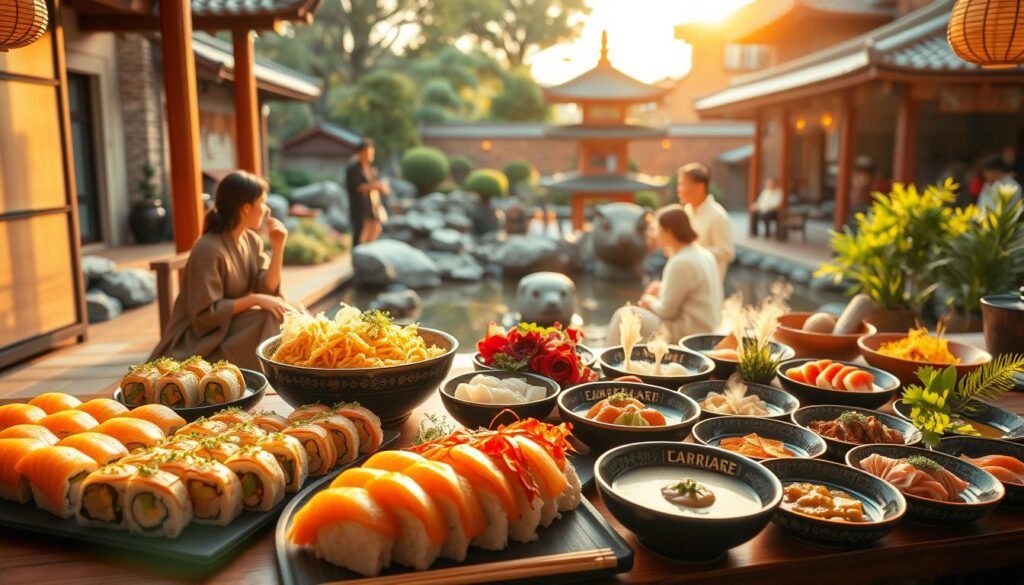
Festivals and Their Signature Dishes
Japanese festivals are full of color, music, and food. The New Year brings osechi ryori, dishes for good fortune. The Hina Matsuri (Doll Festival) has dishes like chirashi sushi and clam soup. Summer festivals feature street foods like takoyaki, taiyaki, and yakisoba. These Japanese festival foods are fun and a big part of traditional Japanese cooking.
Let’s look at some unique festival dishes:
| Festival | Signature Dish | Description |
|---|---|---|
| New Year | Osechi Ryori | An assortment of symbolic dishes served in special bento boxes |
| Hina Matsuri | Chirashi Sushi | Sushi rice topped with various ingredients like seafood and vegetables |
| Summer Matsuri | Takoyaki | Ball-shaped snacks with diced octopus, cooked in a molded pan |
How to Pair Japanese Food with Beverages
Pairing Japanese food with the right drinks can make your meal even better. Sake and Japanese tea add unique flavors to your food. They can change how you enjoy your meal.
Sake: Finding the Right Match
Sake is a Japanese rice wine with many tastes. Learning from a Japanese sake guide is useful. For example, light Junmai Daiginjo is good with sushi. Its fruity flavors match well. But, rich Kimoto or Yamahai sake goes with grilled meats or tempura. Think about the taste and texture of both food and sake when pairing.
Trying different sake and food combinations can open up new flavors. It makes the dining experience more exciting!
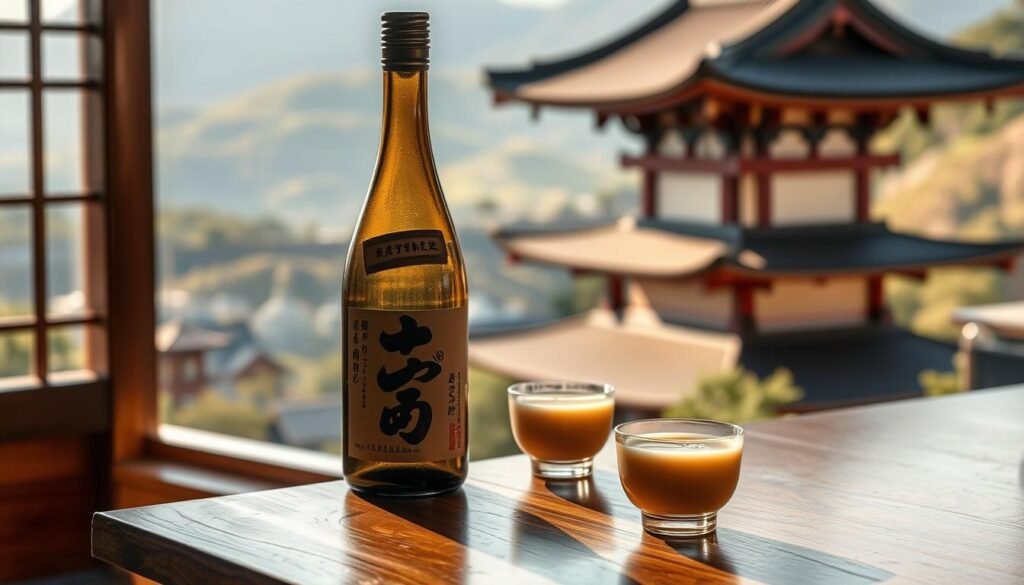
Tea: Enhancing the Dining Experience
Japanese teas like Sencha, Hojicha, and Genmaicha offer different tastes. Sencha is grassy and a bit sweet. It’s good with sushi or sashimi. Hojicha has a smoky taste, matching well with grilled dishes. Meanwhile, Genmaicha, with green tea and roasted rice, is nutty. It’s great for light bites or appetizers.
Remember to try food with tea in your next Japanese meal. This tradition values flavor harmony and respect for food. It makes the dining special.
Conclusion: Making Japanese Dinner Recipes a Family Tradition
Making Japanese dishes at home is a wonderful way to start a family tradition. You can cook meals that will make everyone happy. From sushi making to stir-frying udon, there’s a dish for all skill levels. Imagine your whole family cooking together in the kitchen. That would be so fun, right? Plus, cooking these meals is a great chance for everyone to spend time together.
Starting this tradition helps bring new tastes and ways of cooking to your family. Children can enjoy rolling sushi or mixing their own miso soup. Doing this often brings everyone closer and sparks interest in different foods. And the best part? You get to enjoy Japanese food right at your home. This lets everyone learn and love this amazing food culture.
Why not make these meals a family tradition, then? Enjoying a Japanese meal together can make special memories and bring your family closer. There are many recipes that are both traditional and simple. So, making this a family tradition is easy and enjoyable. Are you ready to make every meal special? Let’s embrace the happiness and traditions of Japanese dining in your home!